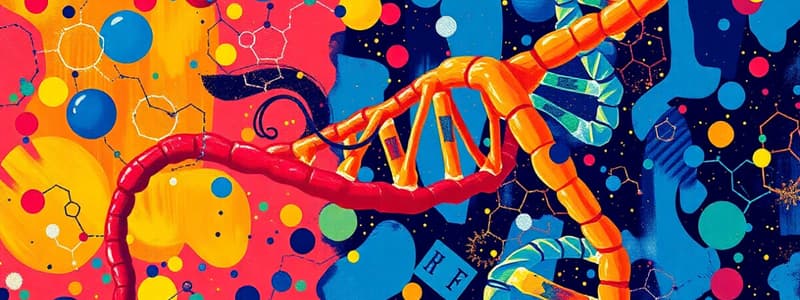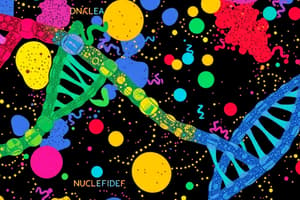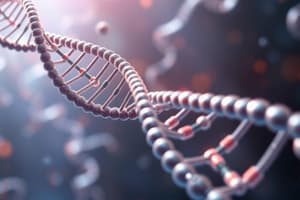Podcast
Questions and Answers
Which characteristic differentiates nucleosides from nucleotides?
Which characteristic differentiates nucleosides from nucleotides?
- Nucleosides contain a sugar and a nitrogenous base. (correct)
- Nucleosides are always part of DNA.
- Nucleosides do not contain a nitrogenous base.
- Nucleosides contain a phosphate group.
What role do redox coenzymes play in cellular processes?
What role do redox coenzymes play in cellular processes?
- They catalyze the formation of nucleic acids.
- They facilitate oxidation-reduction reactions. (correct)
- They store genetic information.
- They serve as energy carriers.
In what ways do RNA and DNA fundamentally differ in their chemical behavior?
In what ways do RNA and DNA fundamentally differ in their chemical behavior?
- DNA can form enzymatic catalysis, whereas RNA cannot.
- RNA has a deoxyribose sugar, while DNA contains ribose.
- DNA is usually double-stranded, whereas RNA is single-stranded. (correct)
- RNA contains thymine, while DNA contains uracil.
Which type of unusual DNA structure can be encountered, and how is it generated?
Which type of unusual DNA structure can be encountered, and how is it generated?
Which of the following bases are found in RNA but not in DNA?
Which of the following bases are found in RNA but not in DNA?
Which structural feature is primarily associated with mRNA?
Which structural feature is primarily associated with mRNA?
What are the consequences of DNA damage caused by UV radiation?
What are the consequences of DNA damage caused by UV radiation?
What is a primary physiological consequence of non-enzymatic reactions involving nucleotides?
What is a primary physiological consequence of non-enzymatic reactions involving nucleotides?
What is the structural characteristic of natural DNA?
What is the structural characteristic of natural DNA?
What is the diameter of a DNA double helix?
What is the diameter of a DNA double helix?
What is observed regarding hydrogen bonding between the base pairs in DNA?
What is observed regarding hydrogen bonding between the base pairs in DNA?
Which of the following describes the melting temperature (tm) of DNA?
Which of the following describes the melting temperature (tm) of DNA?
Which statement accurately describes transfer RNA (tRNA)?
Which statement accurately describes transfer RNA (tRNA)?
What unusual characteristic can certain RNA sequences exhibit?
What unusual characteristic can certain RNA sequences exhibit?
Which form of DNA is characterized by having a symmetrical sequence within each strand?
Which form of DNA is characterized by having a symmetrical sequence within each strand?
What role does the stacking energy of nucleotides play in DNA stability?
What role does the stacking energy of nucleotides play in DNA stability?
What is one potential outcome of spontaneous nucleotide changes?
What is one potential outcome of spontaneous nucleotide changes?
Which statement about unusual DNA structures is true?
Which statement about unusual DNA structures is true?
What is the frequency of nucleotide loss due to hydrolysis each day?
What is the frequency of nucleotide loss due to hydrolysis each day?
Which of the following compounds is primarily responsible for methylation of DNA in vivo?
Which of the following compounds is primarily responsible for methylation of DNA in vivo?
What is a potential consequence of excessive methylation of DNA?
What is a potential consequence of excessive methylation of DNA?
Which class of agents can be used to damage DNA and kill cancer cells?
Which class of agents can be used to damage DNA and kill cancer cells?
What mechanism does the anticancer agent doxorubicin employ to inhibit DNA transcription?
What mechanism does the anticancer agent doxorubicin employ to inhibit DNA transcription?
What is the primary role of S-adenosyl methionine in cellular processes?
What is the primary role of S-adenosyl methionine in cellular processes?
What condition results from the deficiency of UV-specific endonuclease?
What condition results from the deficiency of UV-specific endonuclease?
Which of the following statements about alkylating agents is true?
Which of the following statements about alkylating agents is true?
Which of the following terms describes non-cancerous tissues?
Which of the following terms describes non-cancerous tissues?
Which is a consequence of UV radiation on DNA molecules?
Which is a consequence of UV radiation on DNA molecules?
What role do dialkylators play in the process of DNA modification?
What role do dialkylators play in the process of DNA modification?
How does UV radiation contribute to overall DNA damage caused by environmental agents?
How does UV radiation contribute to overall DNA damage caused by environmental agents?
Which of the following is NOT a known function of methylation in cells?
Which of the following is NOT a known function of methylation in cells?
What is the primary function of nucleotides in living organisms?
What is the primary function of nucleotides in living organisms?
Which of the following is NOT a requirement for nucleotides?
Which of the following is NOT a requirement for nucleotides?
How many hydrogen bonds are formed between adenine and thymine in DNA base pairing?
How many hydrogen bonds are formed between adenine and thymine in DNA base pairing?
What is the significance of the 2'-OH group in RNA compared to DNA?
What is the significance of the 2'-OH group in RNA compared to DNA?
What is formed when nucleotides are linked together?
What is formed when nucleotides are linked together?
Which of the following describes the structural stability of DNA compared to RNA?
Which of the following describes the structural stability of DNA compared to RNA?
What role do cyclic AMP and other cyclic esters of nucleotides play in cells?
What role do cyclic AMP and other cyclic esters of nucleotides play in cells?
Which sugars are components of ribonucleotides and deoxyribonucleotides?
Which sugars are components of ribonucleotides and deoxyribonucleotides?
What does the '5'' to '3'' sequence reading indicate in nucleic acids?
What does the '5'' to '3'' sequence reading indicate in nucleic acids?
Which type of nitrogenous base pairs with guanine in DNA?
Which type of nitrogenous base pairs with guanine in DNA?
What is a defining characteristic of purines compared to pyrimidines?
What is a defining characteristic of purines compared to pyrimidines?
Which statement accurately describes base pairing in nucleic acids?
Which statement accurately describes base pairing in nucleic acids?
What factor contributes to the acidic nature of nucleic acids at physiological pH?
What factor contributes to the acidic nature of nucleic acids at physiological pH?
Which structural feature allows for the self-association of nucleotides?
Which structural feature allows for the self-association of nucleotides?
What distinguishes the metabolic role of ATP from that of other nucleotides?
What distinguishes the metabolic role of ATP from that of other nucleotides?
Flashcards are hidden until you start studying
Study Notes
Nucleotides - Roles
- Building blocks of nucleic acids (DNA, RNA) responsible for storing and transferring genetic information
- Mediators of energy storage and release in metabolic processes (ATP, ADP)
- Signaling molecules: essential chemical links for cell’s response to external stimuli (hormones, temperature, pressure)
Nucleotides - Building Blocks
- Three main structural elements
- Nitrogen-containing base: purines and pyrimidines
- Pentose sugar: ribose or deoxyribose
- Phosphate group
Nucleotides - Bases
- Very stable heterocyclic compounds (aromatic character)
- Flat structures with π electrons
- Exist as tautomers (important for base pairing and chemical reactions)
Nucleosides
- Ribose and ribosides:
- Ribose sugar is a five-carbon sugar found in RNA.
- Ribosides are formed by linking a nitrogenous base to ribose.
- Adenosine is an example of a nucleoside
- 2-deoxyribose and deoxyribosides:
- Deoxyribose sugar is a five-carbon sugar found in DNA.
- Deoxyribosides are formed by linking a nitrogenous base to deoxyribose.
- Deoxyadenosine is an example of a deoxyribonucleoside.
Nucleosides - Conformation
- Sugar puckering: the 5-membered sugar ring can adopt various conformations
- C2’-endo: favored conformation in A-DNA
- C3’-endo: favored conformation in B-DNA
- C2’-exo: favored conformation in Z-DNA
- C3’-exo: favored conformation in some RNA structures
Nucleotides - Isomers
- Phosphate can be attached to different positions on the sugar
- Cyclic esters are possible (e.g., 3’,5’-cyclic AMP)
Nucleic Acids
- DNA and RNA
- Nucleotides linked via phosphodiester bonds
- Phosphate group is ionized at physiological pH, making nucleic acids polyacids
- Sequence is read from 5’ to 3’
Nucleic Acid Stability
- RNA is easily hydrolyzed by alkali because of its 2’-OH group
- DNA is resistant to alkali hydrolysis because it lacks the 2’-OH group
- RNA is older than DNA, but DNA was selected for genetic information storage due to its stability.
Base Pairing in Nucleic Acids
- DNA is a double helix with two antiparallel chains
- Bases are located inside the helix, and the phosphate backbone is located outside
- Base pairs are formed by hydrogen bonding: 2 for A-T, and 3 for G-C.
DNA Structure
- Discovered by J.D. Watson, F.C. Crick, M. Wilkins, and R. Franklin
- Right-handed double helix
- 10.5 base pairs per turn
- Diameter of 2 nm
DNA Forms
- Different forms of DNA exist depending on sequence and environment:
- A-DNA: more compact, right-handed, favored in low humidity
- B-DNA: classic double helix form, right-handed
- Z-DNA: left-handed, favored in high salt concentrations
DNA Replication
- Process of copying DNA
- Requires enzymes like DNA polymerase and helicase
Unusual DNA Structures
- Palindromic DNA sequences: can form alternative structures with intra-strand base pairing (hairpins)
- Triplex DNA: involves three or even four DNA strands (Hoogsteen pairing)
RNA Structure
- Self-complementary sequences can form complex 3D structures
- Single-stranded molecule
- Exists in various conformations (e.g., tRNA, mRNA)
tRNA
- Adapter molecule in protein synthesis
- Covalently linked to an amino acid at one end
- Recognizes mRNA via its anticodon loop
mRNA
- Carries genetic information from DNA to ribosomes
- Contains recognition elements for ribosome binding and protein synthesis initiation
Unusual Base Pairs in RNA
- Non-Watson-Crick base pairs can form (e.g., G=U)
Nucleic Acid Chemistry
- Reversible denaturation: heat can separate DNA strands
- Renaturation: cooled strands can reassociate
- Hybridization: complementary DNA or RNA strands can pair
- Melting temperature (Tm): temperature at which 50% of DNA is denatured
Non-enzymatic Reactions of Nucleotides
- Spontaneous deamination and hydrolysis can occur:
- Deamination: cytosine to uracil
- Hydrolysis: purine bases can be lost
- Repair mechanisms usually handle these changes
Alkylation of DNA
- Methylation of DNA is a natural process used to regulate gene expression
- Excessive methylation can cause mutations and cancer
- Alkylating agents can damage DNA:
- Methylators: add methyl groups
- Dialkylating agents: add two reactive arms, leading to cross-linked DNA chains.
Alkylating Agents - Cancer Therapy
- Alkylating agents are toxic but can be used as antineoplastics (anti-cancer drugs)
- Used to damage cancer cell DNA and prevent their replication
Inhibitors of DNA Transcription
- Intercalating agents: insert between base pairs, bending the DNA and preventing transcription (e.g., doxorubicin)
Damage of DNA by UV Radiation
- UV radiation can cause chemical changes in DNA via photochemical reactions
- Responsible for a significant portion of environmentally-induced DNA damage
- Xeroderma pigmentosum: a genetic disorder caused by the lack of a UV-specific endonuclease that repairs thymine dimers.
Other Functions of Nucleotides
-
Components of coenzymes (e.g., NAD+, FAD)
-
Essential for metabolic reactions (e.g., ATP, GTP)
-
Signaling molecules (e.g., cAMP)### Nucleotides: Building Blocks of Life
-
Structure: Consist of a nitrogenous base, a five-carbon sugar (pentose), and one to three phosphate groups.
-
Nucleosides: Similar to nucleotides but lack the phosphate group.
-
Nitrogenous Bases: Adenine (A), guanine (G), cytosine (C), thymine (T) (found in DNA), and uracil (U) (found in RNA).
-
DNA: Composed of deoxyribose sugar, A, G, C, and T.
-
RNA: Composed of ribose sugar, A, G, C, and U.
-
Unusual Nucleosides in DNA/RNA: Present in small amounts and play a role in regulation and structure.
Phosphate Isomers:
- Different positions of phosphate groups in nucleotides affect their function.
Nucleic Acid Structure
- DNA: Double helix, composed of two antiparallel strands held together by hydrogen bonds between complementary bases (A-T, G-C).
- RNA: Primarily single-stranded, may form complex secondary structures, with diverse functions.
- DNA Forms: A, B, and Z DNA. Differ in their helix geometry and structure.
Unusual DNA Structures
- Non-B DNA forms: Can arise due to sequence, environment, or protein binding. Include cruciform, triplex, and quadruplex structures.
- RNA Secondary Structure: Complex folding patterns create functional domains like loops, stems, and bulges.
Messenger RNA (mRNA) Structure
- 5′ cap: Modified guanine nucleotide, protecting from degradation.
- Coding sequence: Contains the genetic information for protein synthesis.
- Poly(A) tail: String of adenine residues, enhancing stability.
DNA Denaturation
- Reversible process where hydrogen bonds between base pairs are broken, disrupting the double helix.
- Melting Temperature (Tm): Temperature at which half the DNA strands are denatured.
- Hybridization: Complementary DNA strands can re-associate after denaturation.
Non-Enzymatic Reactions of Nucleotides
- Hydrolysis: Cleavage of phosphodiester bonds, breaking down nucleic acids.
- Depurination: Loss of purine bases (A and G), leading to DNA damage.
- Deamination: Conversion of cytosine to uracil, can lead to mutations.
UV Radiation Damage to DNA
- Pyrimidine dimers: Abnormal covalent bonds between adjacent thymine or cytosine bases, hindering replication.
- Xeroderma pigmentosum: Genetic disorder causing sensitivity to UV radiation, increasing skin cancer risk.
Additional Functions of Nucleotides
- Signal transduction
- Energy metabolism: ATP (adenosine triphosphate) as the primary energy carrier.
- Coenzyme function: NAD+ (nicotinamide adenine dinucleotide) and FAD (flavin adenine dinucleotide) in redox reactions.
Studying That Suits You
Use AI to generate personalized quizzes and flashcards to suit your learning preferences.




